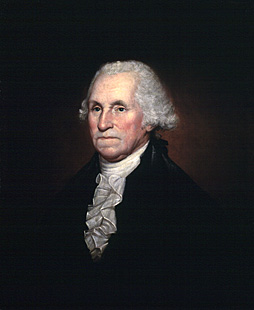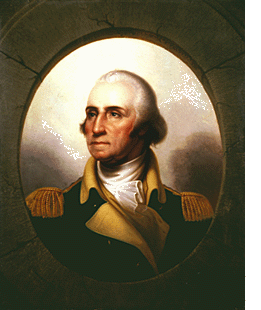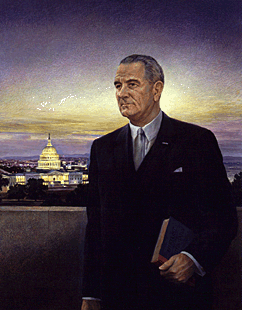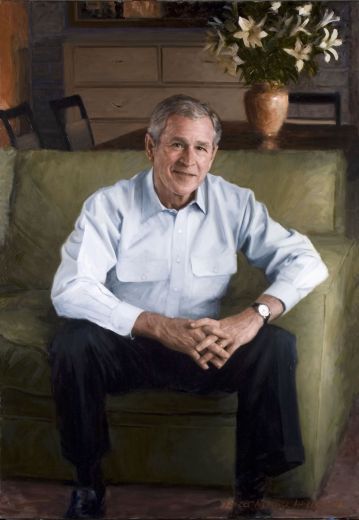Yesterday, former president George W. Bush returned to the White House for the first time since 2010, for the unveiling of his official presidential portrait. The image is a good likeness (though I'm not a huge fan of the somewhat bland, washed-out style). The portrait of Laura Bush was revealed as well, and it's pretty good too:
It got me wondering about presidential portraits. What's the deal with them? How long have they been around? Are there 'official' versus 'unofficial' portraits? Who pays for them? Who owns them?
The answers seem to be a bit muddled, as would be expected in over two hundred years of history. In recent decades, an official portrait is done of each president and first lady by an artist of their choosing. It is paid for by the White House Historical Association (WHHA), which is a private non-profit that was originally founded by Jaqueline Kennedy. The WHHA is well known as the vehicle through which most of the redecorations and alterations of the official White House state rooms are conducted. I'm not sure of the exact relationship between it, the National Park Service (which runs the White House grounds, officially called the "Presidential Park"), and the official White House, but there seems to be a lot of interconnectedness there.
The WHHA also owns many of the portraits, acting as stewards of "The White House Collection" via the White House Acquisition Trust. Presidents are given the chance to choose where to hang the various portraits of previous presidents in the collection. For example, when Ronald Reagan became president, he had the portrait of Calvin Coolidge moved from the Grand Hall of the White House into the Cabinet Room in the West Wing, next to a portrait of Thomas Jefferson. Both are famous for their small-government philosophies, so Reagan must've felt that he'd like them to be a visual philosophical reminder for those in his administration.
Who owns the other portraits? Almost all of them are held by the National Portrait Gallery of the Smithsonian. A few are held by various libraries (including the Library of Congress, I believe) and presidential homesteads (such as Monticello and Mount Vernon).
As for what's "official" and what's "unofficial," I have no idea. My best understanding seems to be whether it is a portrait of the president as president, painted with the understanding of the president (not by a random person), and whether it is owned by a public or publicly-involved entity.
So, that's who owns and distributes them and what makes them 'official.' But what about the portraits themselves?
Well, certainly the most famous one is the Gilbert Stuart portrait of George Washington, known as the "Lansdowne Portrait":
It got me wondering about presidential portraits. What's the deal with them? How long have they been around? Are there 'official' versus 'unofficial' portraits? Who pays for them? Who owns them?
The answers seem to be a bit muddled, as would be expected in over two hundred years of history. In recent decades, an official portrait is done of each president and first lady by an artist of their choosing. It is paid for by the White House Historical Association (WHHA), which is a private non-profit that was originally founded by Jaqueline Kennedy. The WHHA is well known as the vehicle through which most of the redecorations and alterations of the official White House state rooms are conducted. I'm not sure of the exact relationship between it, the National Park Service (which runs the White House grounds, officially called the "Presidential Park"), and the official White House, but there seems to be a lot of interconnectedness there.
The WHHA also owns many of the portraits, acting as stewards of "The White House Collection" via the White House Acquisition Trust. Presidents are given the chance to choose where to hang the various portraits of previous presidents in the collection. For example, when Ronald Reagan became president, he had the portrait of Calvin Coolidge moved from the Grand Hall of the White House into the Cabinet Room in the West Wing, next to a portrait of Thomas Jefferson. Both are famous for their small-government philosophies, so Reagan must've felt that he'd like them to be a visual philosophical reminder for those in his administration.
Who owns the other portraits? Almost all of them are held by the National Portrait Gallery of the Smithsonian. A few are held by various libraries (including the Library of Congress, I believe) and presidential homesteads (such as Monticello and Mount Vernon).
As for what's "official" and what's "unofficial," I have no idea. My best understanding seems to be whether it is a portrait of the president as president, painted with the understanding of the president (not by a random person), and whether it is owned by a public or publicly-involved entity.
So, that's who owns and distributes them and what makes them 'official.' But what about the portraits themselves?
Well, certainly the most famous one is the Gilbert Stuart portrait of George Washington, known as the "Lansdowne Portrait":
Interestingly enough, the portrait was commissioned by a U.S. Senator from Pennsylvania as a gift for an American sympathizer in the British Parliament, William Petty, Marquess of Lansdowne (hence the name). It is unknown who owned the original until 2001, when it was bought for $30 million dollars and given to the National Portrait Gallery. However, the portrait had been on official loan and display for a very, very long time.
The painting is most famous for being saved by First Lady Dolley Madison from the torching of the White House during the War of 1812. It seems, however, that the one saved is not the original, but a replica, also painted by Gilbert Stuart. Two more replicas done by the original artist are on display, and two more replicas done by different artists are on display in the U.S. Capitol.
Here are two more of Washington, both done by Rembrandt Peale, and held in the collection of the National Portrait Gallery. According to the Gallery's website, young Rembrandt Peale was so nervous to be painting the illustrious Washington that his father, Charles Willson Peale (another famous American portrait artist) had to come with him to sittings to keep him calm:
Gilbert Stuart, Rembrandt Peale, Charles Willson Peale, and an artist named John Trumball were the main portraitists of the early American period (though Trumball's most famous images are his portrait of Alexander Hamilton, which appears on the ten dollar bill and the signing of the Declaration of Independence, on display in the U.S. Capitol rotunda and reprinted on the back of the two dollar bill).
Many of the early portraits, then, were simply commissioned by the presidents themselves or their various compatriots. Apparently, in 1800, Congress did allocate $700 to purchase the Lansdowne portrait of Washington. Beyond that, however, it doesn't seem that the government did much purchasing of art (the Smithsonian wasn't founded until 1846, and the White House didn't really have much of a budget in the early days--in fact, I recall reading a few years ago that it wasn't until the early 1900's that president's didn't have to pay for their official State functions out of their own pockets).
The next notable portrait is the famous one of Abraham Lincoln, leaning forward in his chair, deep in thought. It currently hangs (and has for quite some time) above the mantle in the State Dining Room in the White House:
Interestingly, this portrait was not done in Lincoln's lifetime. And, it wasn't the original official portrait of Lincoln. In 1869, an official portrait contest, put on by Congress, with the winner chosen by President Ulysses S. Grant selected this portrait of Lincoln instead:
The famous one was owned by Lincoln's son, Robert, and eventually bought and hung in the White House.
The next one is probably my favorite portrait in the collection, primarily because it was done by one of my favorite artists of all time, John Singer Sargent. I recount what I remember about it from Edmund Morris's excellent biography, Theodore Rex.
Apparently, the president and Sargent had been going at it for a long time, with Sargent continually unhappy with how Roosevelt was posing. There was something off, and Roosevelt's character simply wasn't coming through in the way Sargent wanted. As both a very energetic and irascible man, Roosevelt grew impatient, and was about to burst into a tirade against the artist for wasting his time. He put one hand on his hip and tightened his grip on the knob of the staircase he was standing next to. As he began to step forward, his face contorted in determined anger, Sargent told him to stop. His pose was perfect! And today, we are left with that--an image of a perturbed Roosevelt, brimming with pent-up energy, which hangs in the East Room, on the other side of the wall as the Lansdowne Washington portrait:
Another interesting story is that of the John Kennedy portrait. Jaqueline had it commissioned after his assassination by one of her favorite artists, who created a stunning image of JFK in deep thought. His pose exhibits all alone in the power of his office. It's totally different than the other official portraits, in that the president is in a pose that doesn't show his face. My mom thinks it's stupid. I love it. It's my second favorite, after the Roosevelt one above:
Kennedy, of course, was followed in office by Lyndon Johnson, who was his Vice President and, previously, the majority leader in the U.S. Senate, hailing from Texas. Johnson's first official portrait was well done (I think), with the artist including the Capitol in the background (since he had served there for many decades) and a lovely Texas sunset. Johnson hated it:
Instead, he went with a super-lame totally 1960's-era portrait. Boring!
A similar thing happened with Richard Nixon. Norman Rockwell, the famous portraitist, was commissioned to paint his official portrait. However, when it came back, people looked at it and asked "Would you buy a used car from this man?" It's actually a really well-done portrait (and a better likeness than the official one), but I can see why he wouldn't've wanted it to be the portrait everyone sees of him:
Those are the most interesting ones that I know of. The unofficial portraits owned by the National Portrait Gallery of Reagan and George H.W. Bush are better, in my opinion, than either president's official White House portrait (especially Bush's). I'm not a huge fan of Clinton's official one either.
I do, however, really like this unofficial one of George W. Bush owned by the National Portrait Gallery. It's more relaxed and captures his sense of humor (which, I guess, depending on whether you like him or hate him will probably change whether you like the portrait or not). I have no particular animus against him (also not a big fan of many of his policies, but he seems like a nice enough guy), so I think it's well done:



.jpg)










No comments:
Post a Comment